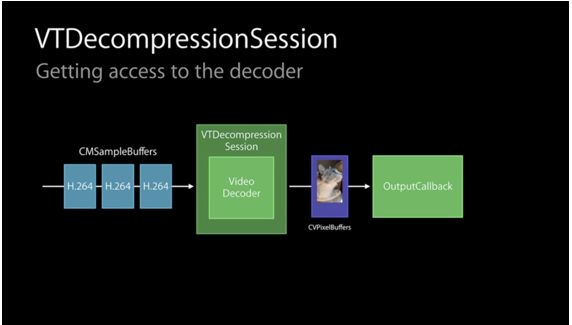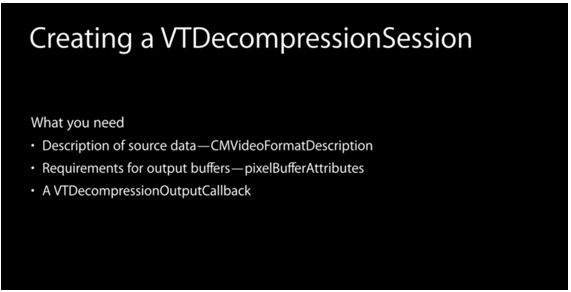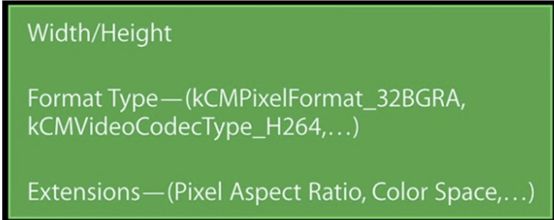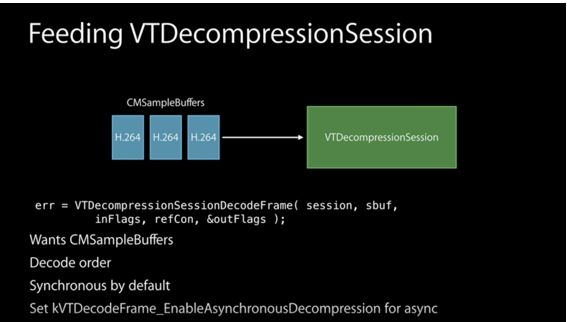解码器VTDecompressionSession
将压缩的CMSampleBuffers数据解码为非压缩的CVPixelBuffers数据,并回调
创建一个解码器,你需要准备的数据
CMFormatDescription
描述了视频的基本信息,有时也用CMVideoFormatDescriptionRef表示
typedef CMFormatDescriptionRef CMVideoFormatDescriptionRef;
示意图:
有3个接口可创建视频格式描述对象CMFormatDescriptionRef
一般视频解码里使用以下方式
const uint8_t* const parameterSetPointers[2] = { (const uint8_t*)[spsData bytes], (const uint8_t*)[ppsData bytes] };
const size_t parameterSetSizes[2] = { [spsData length], [ppsData length] };
status = CMVideoFormatDescriptionCreateFromH264ParameterSets(kCFAllocatorDefault, 2, parameterSetPointers, parameterSetSizes, 4, &videoFormatDescr);
其中
OSStatus CMVideoFormatDescriptionCreateFromH264ParameterSets(
CFAllocatorRef CM_NULLABLE allocator, /*! @param allocator
CFAllocator to be used when creating the CMFormatDescription. Pass NULL to use the default allocator. */
size_t parameterSetCount, /*! @param parameterSetCount
The number of parameter sets to include in the format description. This parameter must be at least 2. */
const uint8_t * CM_NONNULL const * CM_NONNULL parameterSetPointers, /*! @param parameterSetPointers
Points to a C array containing parameterSetCount pointers to parameter sets. */
const size_t * CM_NONNULL parameterSetSizes, /*! @param parameterSetSizes
Points to a C array containing the size, in bytes, of each of the parameter sets. */
int NALUnitHeaderLength, /*! @param NALUnitHeaderLength
Size, in bytes, of the NALUnitLength field in an AVC video sample or AVC parameter set sample. Pass 1, 2 or 4. */
CM_RETURNS_RETAINED_PARAMETER CMFormatDescriptionRef CM_NULLABLE * CM_NONNULL formatDescriptionOut ) /*! @param formatDescriptionOut
Returned newly-created video CMFormatDescription */
第二种方式
CFMutableDictionaryRef atoms = CFDictionaryCreateMutable(NULL, 0, &kCFTypeDictionaryKeyCallBacks,&kCFTypeDictionaryValueCallBacks);
CFMutableDictionarySetData(atoms, CFSTR ("avcC"), (uint8_t *)extradata, extradata_size);
CFMutableDictionaryRef extensions = CFDictionaryCreateMutable(NULL, 0, &kCFTypeDictionaryKeyCallBacks, &kCFTypeDictionaryValueCallBacks);
CFMutableDictionarySetObject(extensions, CFSTR ("SampleDescriptionExtensionAtoms"), (CFTypeRef *) atoms);
CMVideoFormatDescriptionCreate(NULL, format_id, width, height, extensions, &videoFormatDescr);
第三种,从CVImageBufferRef创建
OSStatus CMVideoFormatDescriptionCreateForImageBuffer(
CFAllocatorRef CM_NULLABLE allocator, /*! @param allocator
CFAllocator to be used when creating the CMFormatDescription. NULL will cause the default allocator to be used */
CVImageBufferRef CM_NONNULL imageBuffer, /*! @param imageBuffer
Image buffer for which we are creating the format description. */
CM_RETURNS_RETAINED_PARAMETER CMVideoFormatDescriptionRef CM_NULLABLE * CM_NONNULL formatDescriptionOut) /*! @param formatDescriptionOut
Returned newly-created video CMFormatDescription */
pixelBufferAttributes
创建解码会话时还需要提供一些解码指导信息,如已解码数据是否为OpenGL ES兼容、是否需要YUV转换RGB(此项一般不设置,OpenGL转换效率更高,VideoToolbox转换不仅需要使用更多内存,同时也消耗CPU)等等,如
NSDictionary *destinationImageBufferAttributes =[NSDictionary dictionaryWithObjectsAndKeys:[NSNumber numberWithBool:NO],(id)kCVPixelBufferOpenGLESCompatibilityKey,[NSNumber numberWithInt:kCVPixelFormatType_32BGRA],(id)kCVPixelBufferPixelFormatTypeKey,nil];
VTDecompressionOutputCallbackRecord
创建解码会话需要提供回调函数以便系统解码完成时将解码数据、状态等信息返回给用户
VTDecompressionOutputCallbackRecord callback;
callback.decompressionOutputCallback = didDecompress;
callback.decompressionOutputRefCon = (__bridge void *)self;
回调函数原型如下,每解码一帧视频都调用一次此函数。
void didDecompress( void *decompressionOutputRefCon, void *sourceFrameRefCon, OSStatus status, VTDecodeInfoFlags infoFlags, CVImageBufferRef imageBuffer, CMTime presentationTimeStamp, CMTime presentationDuration )
VTDecompressionSessionRef
准备工作都完成了,现在正式创建解码会话,解码会话的创建函数VTDecompressionSessionCreate
函数
OSStatus
VTDecompressionSessionCreate(
CM_NULLABLE CFAllocatorRef allocator,
CM_NONNULL CMVideoFormatDescriptionRef videoFormatDescription,
CM_NULLABLE CFDictionaryRef videoDecoderSpecification,
CM_NULLABLE CFDictionaryRef destinationImageBufferAttributes,
const VTDecompressionOutputCallbackRecord * CM_NULLABLE outputCallback,
CM_RETURNS_RETAINED_PARAMETER CM_NULLABLE VTDecompressionSessionRef * CM_NONNULL decompressionSessionOut)
使用函数创建
OSStatus status = VTDecompressionSessionCreate(kCFAllocatorDefault,
_decoderFormatDescription,
NULL,
(__bridge CFDictionaryRef)destinationPixelBufferAttributes,
&callBackRecord,
&_deocderSession);
VTDecompressionSessionDecodeFrame进行解码
给解码器填充数据,进行解码,需要压缩数据CMSampleBufferRef
1.CMBlockBufferCreateWithMemoryBlock
将NALU数据拷贝到CMBlockBuffer
CMBlockBufferRef blockBuffer = NULL;
OSStatus status = CMBlockBufferCreateWithMemoryBlock(NULL,
(void *)frame,
frameSize,
kCFAllocatorNull,
NULL,
0,
frameSize,
FALSE,
&blockBuffer);
2.CMSampleBufferCreateReady
创建CMSampleBufferRef
CMSampleBufferRef sampleBuffer = NULL;
const size_t sampleSizeArray[] = {frameSize};
status = CMSampleBufferCreateReady(kCFAllocatorDefault,
blockBuffer,
_decoderFormatDescription ,
1, 0, NULL, 1, sampleSizeArray,
&sampleBuffer);
3.VTDecompressionSessionDecodeFrame
CVPixelBufferRef outputPixelBuffer = NULL;
VTDecodeFrameFlags flags = 0;
VTDecodeInfoFlags flagOut = 0;
OSStatus decodeStatus = VTDecompressionSessionDecodeFrame(_deocderSession,
sampleBuffer,
flags,
&outputPixelBuffer,
&flagOut);
解码前后的数据结构CMSamleBuffer
附解码器代码,直接拷贝到项目既可以使用
#import
NS_ASSUME_NONNULL_BEGIN
@protocol H264DecoderDelegate
- (void)didDecodedFrame:(CVImageBufferRef )imageBuffer;
@end
@interface H264Decoder : NSObject
@property (weak, nonatomic) id delegate;
- (BOOL)initH264Decoder;
- (void)decodeNalu:(uint8_t *)frame withSize:(uint32_t)frameSize;
@end
#import "H264Decoder.h"
#import
#define h264outputWidth 800
#define h264outputHeight 600
@interface H264Decoder ()
@property (nonatomic, assign) uint8_t *sps;
@property (nonatomic, assign) NSInteger spsSize;
@property (nonatomic, assign) uint8_t *pps;
@property (nonatomic, assign) NSInteger ppsSize;
@property (nonatomic, assign) VTDecompressionSessionRef deocderSession;
@property (nonatomic, assign) CMVideoFormatDescriptionRef decoderFormatDescription;
@end
@implementation H264Decoder
#pragma mark - public
- (BOOL)initH264Decoder {
if(_deocderSession) {
return YES;
}
const uint8_t* const parameterSetPointers[2] = { _sps, _pps };
const size_t parameterSetSizes[2] = { _spsSize, _ppsSize };
OSStatus status = CMVideoFormatDescriptionCreateFromH264ParameterSets(kCFAllocatorDefault,
2, //param count
parameterSetPointers,
parameterSetSizes,
4, //nal start code size
&_decoderFormatDescription);
if(status == noErr) {
NSDictionary* destinationPixelBufferAttributes = @{
(id)kCVPixelBufferPixelFormatTypeKey : [NSNumber numberWithInt:kCVPixelFormatType_420YpCbCr8BiPlanarVideoRange],
//硬解必须是 kCVPixelFormatType_420YpCbCr8BiPlanarVideoRange
// 或者是kCVPixelFormatType_420YpCbCr8Planar
//因为iOS是 nv12 其他是nv21
(id)kCVPixelBufferWidthKey : [NSNumber numberWithInt:h264outputHeight*2],
(id)kCVPixelBufferHeightKey : [NSNumber numberWithInt:h264outputWidth*2],
//这里款高和编码反的
(id)kCVPixelBufferOpenGLCompatibilityKey : [NSNumber numberWithBool:YES]
};
VTDecompressionOutputCallbackRecord callBackRecord;
callBackRecord.decompressionOutputCallback = didDecompress;
callBackRecord.decompressionOutputRefCon = (__bridge void *)self;
status = VTDecompressionSessionCreate(kCFAllocatorDefault,
_decoderFormatDescription,
NULL,
(__bridge CFDictionaryRef)destinationPixelBufferAttributes,
&callBackRecord,
&_deocderSession);
VTSessionSetProperty(_deocderSession, kVTDecompressionPropertyKey_ThreadCount, (__bridge CFTypeRef)[NSNumber numberWithInt:1]);
VTSessionSetProperty(_deocderSession, kVTDecompressionPropertyKey_RealTime, kCFBooleanTrue);
} else {
NSLog(@"IOS8VT: reset decoder session failed status=%d", (int)status);
}
return YES;
}
- (void)decodeNalu:(uint8_t *)frame withSize:(uint32_t)frameSize {
// NSLog(@">>>>>>>>>>开始解码");
int nalu_type = (frame[4] & 0x1F); //16进制,16进制的-位,对应二进制的4位,16进制的两位对应二进制的8位,就是一字节,0x1F转为10进制就是31,转为二进制是11111,& 运算 真真为真,其中frame[4]表示开始码后第一个byte的地址,所以frame[4] & 0x1F表示取开始码后第一个byte的后5位,开始码后第一个byte的后5位,7代表sps,8代表pps。定位NALU的类型是什么
CVPixelBufferRef pixelBuffer = NULL;
// 将NALU的开始码转为4字节大端NALU的长度信息
/**
字节排序按分为大端和小端,概念如下
大端(big endian):低地址存放高有效字节
小端(little endian):低字节存放地有效字节
现在主流的CPU,intel系列的是采用的little endian的格式存放数据,而motorola系列的CPU采用的是big endian,ARM则同时支持 big和little,网络编程中,TCP/IP统一采用大端方式传送数据,所以有时我们也会把大端方式称之为网络字节序。
https://www.cnblogs.com/Romi/archive/2012/01/10/2318551.html
1.大端和小端的方式及判断
举个例子说明,我的机子是32位windows的系统,处理器是AMD的。对于一个int型数0x12345678,为方便说明,这里采用16进制表示。这个数在不同字节顺序存储的CPU中储存顺序如下:
0x12345678 16进制,两个数就是一字节
高有效字节——>低有效字节: 12 34 56 78
低地址位 高低址位
大端: 12 34 56 78
小端: 78 56 34 12
下面是将小端转大端
在工作中遇到一个问题,数据是以大端模式存储的,而机器是小端模式,必须进行转换,否则使用时会出问题
看到有人这样处理的https://www.cnblogs.com/sunminmin/p/4976418.html
B. 用4字节长度代码(4 byte length code (the length of the NalUnit including the unit code))替换分隔码(separator code)
int reomveHeaderSize = packet.size - 4;
const uint8_t sourceBytes[] = {(uint8_t)(reomveHeaderSize >> 24), (uint8_t)(reomveHeaderSize >> 16), (uint8_t)(reomveHeaderSize >> 8), (uint8_t)reomveHeaderSize};
status = CMBlockBufferReplaceDataBytes(sourceBytes, videoBlock, 0, 4);
*/
uint32_t nalSize = (uint32_t)(frameSize - 4);
uint8_t *pNalSize = (uint8_t*)(&nalSize);
frame[0] = *(pNalSize + 3);
frame[1] = *(pNalSize + 2);
frame[2] = *(pNalSize + 1);
frame[3] = *(pNalSize);
//传输的时候。关键帧不能丢数据 否则绿屏 B/P可以丢 这样会卡顿
switch (nalu_type)
{
case 0x05:
// NSLog(@"nalu_type:%d Nal type is IDR frame",nalu_type); //关键帧
if([self initH264Decoder])
{
pixelBuffer = [self decode:frame withSize:frameSize];
}
break;
case 0x07:
// NSLog(@"nalu_type:%d Nal type is SPS",nalu_type); //sps
_spsSize = frameSize - 4;
_sps = malloc(_spsSize);
memcpy(_sps, &frame[4], _spsSize);
break;
case 0x08:
{
// NSLog(@"nalu_type:%d Nal type is PPS",nalu_type); //pps
_ppsSize = frameSize - 4;
_pps = malloc(_ppsSize);
memcpy(_pps, &frame[4], _ppsSize);
break;
}
default:
{
// NSLog(@"Nal type is B/P frame");//其他帧
if([self initH264Decoder])
{
pixelBuffer = [self decode:frame withSize:frameSize];
}
break;
}
}
}
#pragma mark - private
//解码回调函数
static void didDecompress(void *decompressionOutputRefCon, void *sourceFrameRefCon, OSStatus status, VTDecodeInfoFlags infoFlags, CVImageBufferRef pixelBuffer, CMTime presentationTimeStamp, CMTime presentationDuration) {
CVPixelBufferRef *outputPixelBuffer = (CVPixelBufferRef *)sourceFrameRefCon;
*outputPixelBuffer = CVPixelBufferRetain(pixelBuffer);
H264Decoder *decoder = (__bridge H264Decoder *)decompressionOutputRefCon;
if (decoder.delegate!=nil)
{
[decoder.delegate didDecodedFrame:pixelBuffer];
}
}
-(CVPixelBufferRef)decode:(uint8_t *)frame withSize:(uint32_t)frameSize {
CVPixelBufferRef outputPixelBuffer = NULL;
CMBlockBufferRef blockBuffer = NULL;
OSStatus status = CMBlockBufferCreateWithMemoryBlock(NULL,
(void *)frame,
frameSize,
kCFAllocatorNull,
NULL,
0,
frameSize,
FALSE,
&blockBuffer);
if(status == kCMBlockBufferNoErr) {
CMSampleBufferRef sampleBuffer = NULL;
const size_t sampleSizeArray[] = {frameSize};
status = CMSampleBufferCreateReady(kCFAllocatorDefault,
blockBuffer,
_decoderFormatDescription ,
1, 0, NULL, 1, sampleSizeArray,
&sampleBuffer);
if (status == kCMBlockBufferNoErr && sampleBuffer) {
VTDecodeFrameFlags flags = 0;
VTDecodeInfoFlags flagOut = 0;
OSStatus decodeStatus = VTDecompressionSessionDecodeFrame(_deocderSession,
sampleBuffer,
flags,
&outputPixelBuffer,
&flagOut);
if(decodeStatus == kVTInvalidSessionErr) {
NSLog(@"IOS8VT: Invalid session, reset decoder session");
} else if(decodeStatus == kVTVideoDecoderBadDataErr) {
NSLog(@"IOS8VT: decode failed status=%d(Bad data)", (int)decodeStatus);
} else if(decodeStatus != noErr) {
NSLog(@"IOS8VT: decode failed status=%d", (int)decodeStatus);
}
CFRelease(sampleBuffer);
}
CFRelease(blockBuffer);
}
return outputPixelBuffer;
}
@end
疑惑
上面的这个代码的用处?
uint32_t nalSize = (uint32_t)(frameSize - 4);
uint8_t *pNalSize = (uint8_t*)(&nalSize);
frame[0] = *(pNalSize + 3);
frame[1] = *(pNalSize + 2);
frame[2] = *(pNalSize + 1);
frame[3] = *(pNalSize);
由于VideoToolbox解码器只接受MPEG-4流,当接收到Elementary Stream形式的H.264流,需把Start Code(3- or 4-Byte Header)换成Length(4-Byte Header)。







